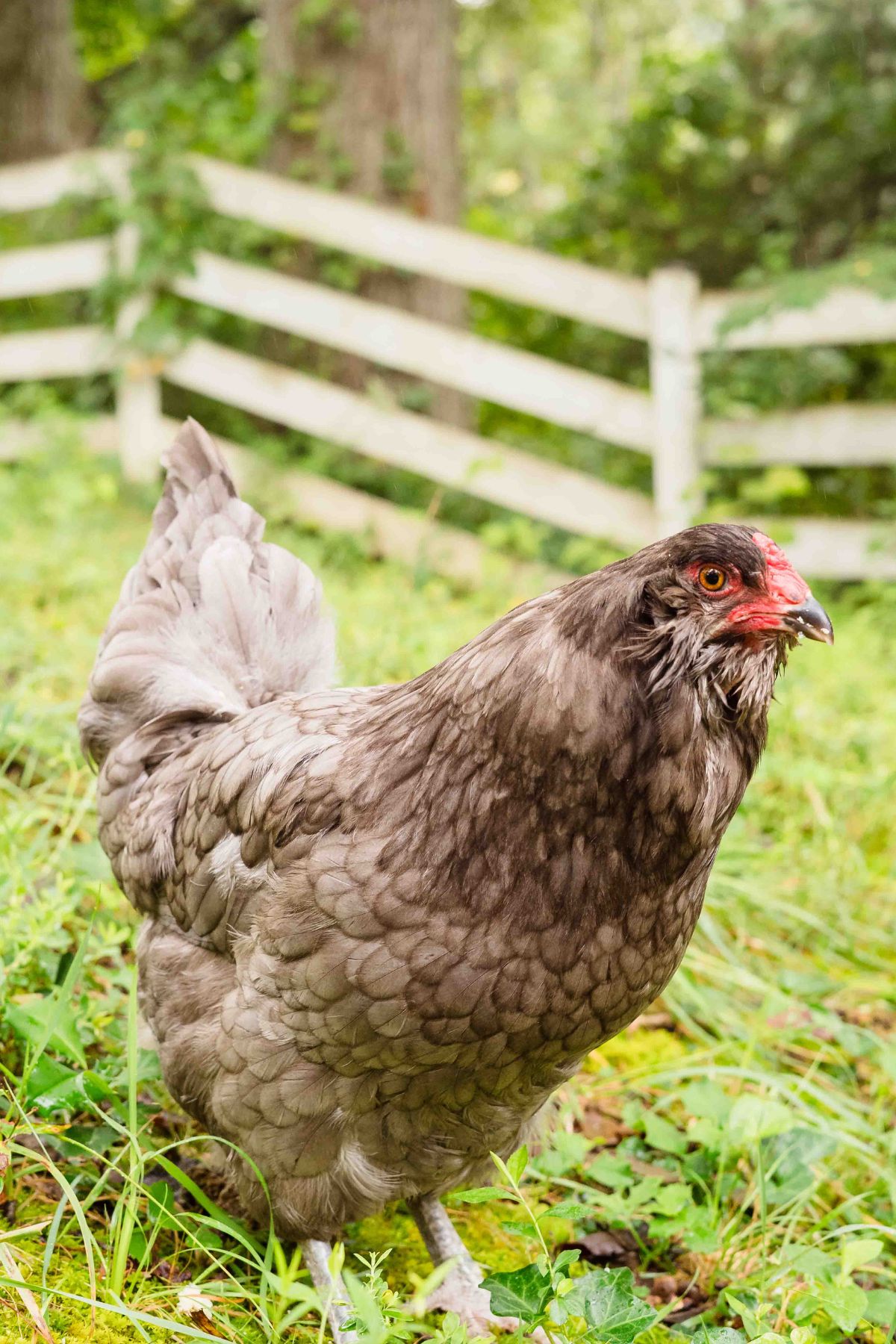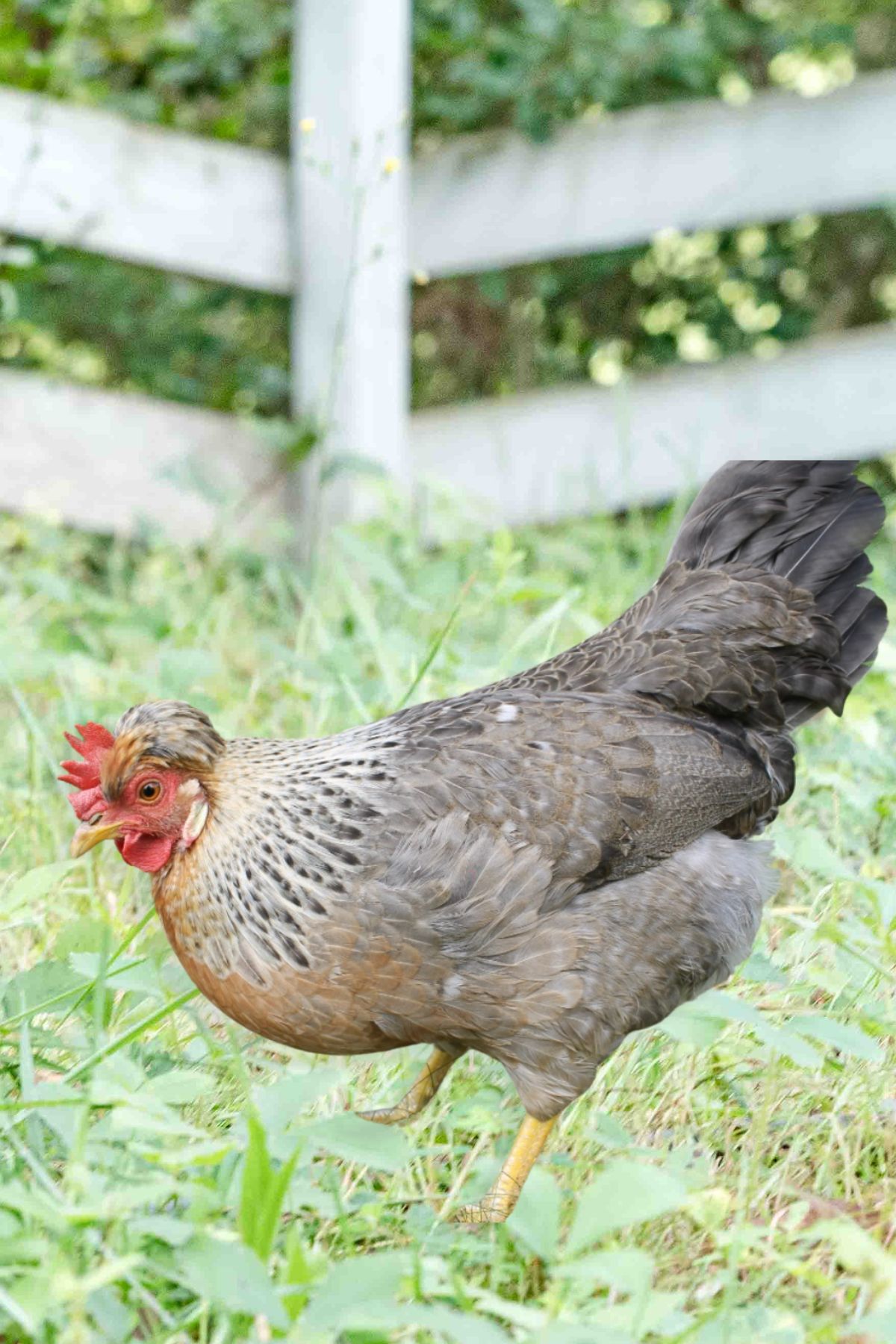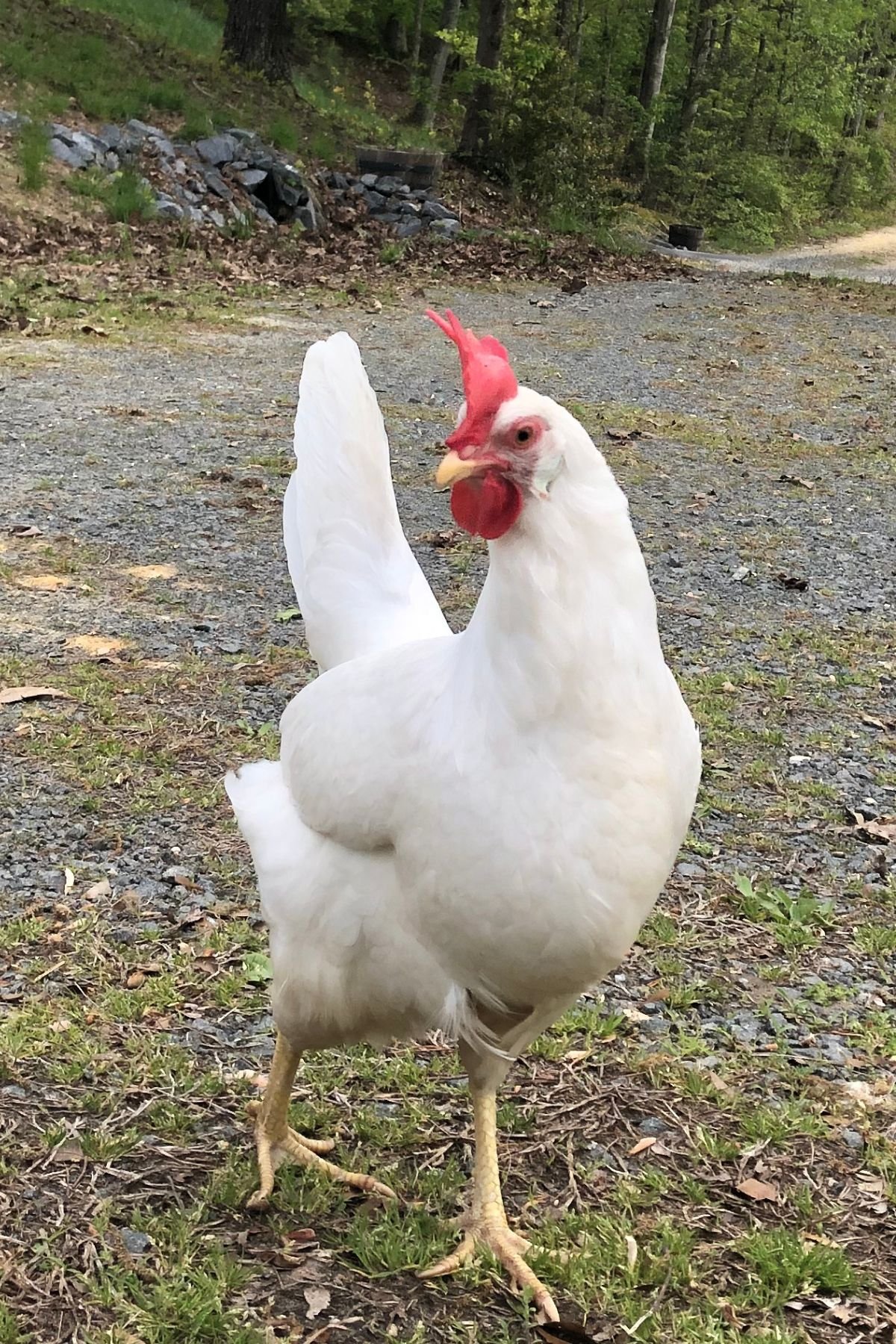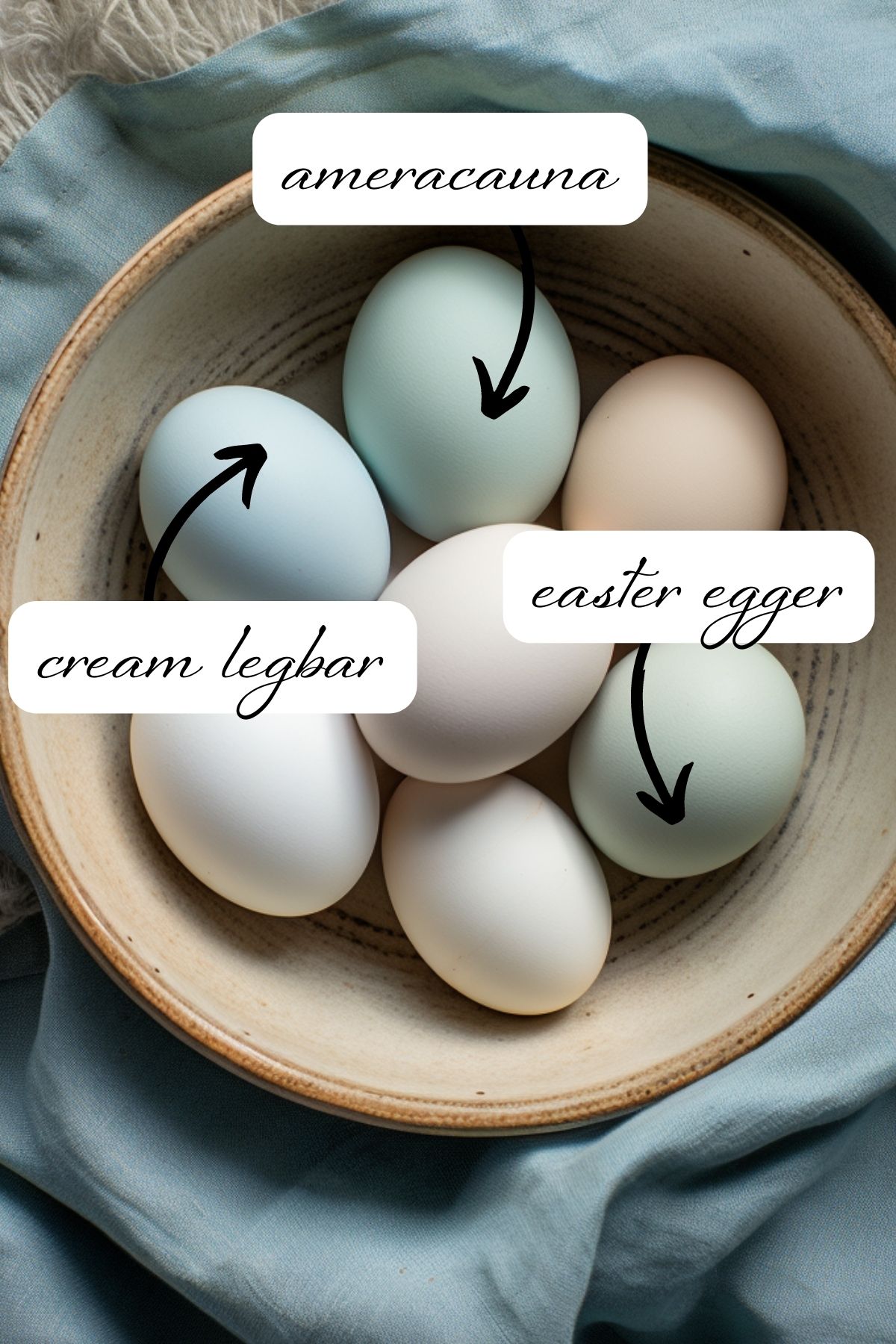Favorite Chickens That Lay Blue Eggs {From Aqua to Robin’s Egg}
Once you start raising chickens that lay blue eggs, you’ll never again have a flock without them. There’s nothing like a beautiful egg basket to make something simple feel so special.

These are the five best blue egg-laying backyard chicken breeds to add color and beauty to every day.
1. Ameraucana
Characteristics
This is a pure breed recognized for their blue egg-laying capability. They have a unique look with tufts near their ears and come in various colors like black, white, and blue. They can be hard to identify because they have many feather colors. Colorations include:
- Lavender
- White
- Black
- Splash (a mix of light and dark feathers)
Just look for the beards! They will all have this feature.
They are quite large and fluffy-looking with big feathers. A very cute breed!

Temperament
These birds are known for their calm and friendly disposition. They are easy to handle and are generally good with families and children.
Egg-laying Rate
Ameraucanas are moderate to good layers, offering about 200-280 blue eggs annually. The eggs are medium-sized. They are the first of my hens to stop laying in fall and the last to restart in the spring.
Ameraucanana Pros and Cons
Pros:
- Friendly and good with people
- Hardy in different climates
- Lays medium to large blue eggs
Cons:
- May be less productive in egg-laying compared to some other breeds
- Can be pricey to purchase
- Poor winter laying (in my experience
2. Cream Legbar
Characteristics
Cream Legbars are another breed that is famous for their blue eggs. They have a distinct appearance, with a crest on their head, and often have silver or gold-colored feathers.

Temperament
They are active and curious birds but are generally friendly and easy to handle. They also tend to be good foragers.
Egg-laying Rate
Cream Legbars are good layers, typically laying around 230-270 eggs per year. Their blue eggs are usually medium to large in size.
Cream Legbar Pros and Cons
Pros:
- Friendly and good with kids
- Easy to tell males from females at hatching
- Cute tufted hair. 😊
Cons:
- Not as hardy in cold weather
- Can be noisy
The Cream Legbar is my favorite blue egg layer because I find it cute and love the shade of robin’s egg of blue. Like many aspects of choosing chicken breeds, this is pure personal preference. One is not better than the other.
3. Araucana
Characteristics
Araucanas are a rare breed known for their blue eggs. They have a distinct “rumpless” look, meaning they lack tail feathers, and some have tufts near their ears.
Temperament
These birds are more on the independent side but can be friendly. They’re not as social as some other breeds but are generally easy to care for.
Egg-laying Rate
Expect around 160-200 blue eggs per year from an Araucana. These eggs are medium-sized but a gorgeous shade of blue.
Araucana Pros and Cons
Pros:
- Unique look with ear tufts and no tail (you not consider this a pro!)
- Quiet and calm
- Lays true blue eggs
Cons:
- Hard to find
- Can be shy, not as social
- Some breeding lines may have health issues
4. Azur Blue
The Azur chicken is a breed that is specifically bred for its unique blue eggshell color. Its exact lineage is a secret, and the chicks are only available from Hendrix Genetics.
Developed by Hendrix Genetics, it is a robust and friendly bird that is well-suited for small-scale and backyard egg producers.
The breed prides itself on producing eggs with good shell strength and a consistent, light turquoise blue color.
In terms of appearance, the Azur has an elegant look with a lasting silver-white feather cover.

One notable feature of the Azur laying hens is that 50% of their genes come from White Leghorns, a breed known for its high productivity. This genetic background makes the Azur highly productive and a “thrifty” bird, meaning it consumes little feed compared to how many eggs it produces.
Pros and cons of Azur blue chickens
- Blue Egg Color: Lays unique, turquoise blue eggs which can be aesthetically pleasing.
- Good Egg Quality: Known for good eggshell strength, making the eggs less likely to break.
- High Productivity: Inherits 50% of its genes from White Leghorns, making it a highly productive layer.
Cons:
- Specialized Breed: Expensive and only available from one breeder
- Flightiness. Its high amount of Leghorn genes makes it prone to flightiness. (Flapping all around the place acting crazy.)
5. Easter Eggers
Easter Eggers are not a true breed, which means they are a mix of different chicken breeds. This gives them a unique and varied appearance. You can find Easter Eggers in many different colors and feather patterns, making each bird distinct. They add a lot of variety to a backyard flock, both in how they look and in the colors of eggs they lay.

Speaking of eggs, Easter Eggers are known for laying a mix of different egg colors. To be clear, a chicken will only lay one color of egg its entire life. But some Easter Eggers will lay true blue, some true green, some a blend of blue and green, and some brown. There is no way to tell which color they will lay ahead of time.
Regarding temperament, Easter Eggers are usually quite friendly and often recommended for beginners. They tend to get along well with people and other chickens. This makes them a good choice for families or those new to keeping chickens in their backyard.
Easter Egger Pros and Cons:
- Affordable chicks and good for beginners
- Varied and colorful feather patterns
- Lays different colors of eggs, including blue
Cons:
- Not a consistent layer of only blue eggs
- Not a pure breed, so traits can vary widely
What’s the point of blue egg layers?
They’re just fun and pretty. 😉
In terms of nutrition, they’re the same as any other egg. But the blue makes them stand out, offering your egg collection a beautiful and whimsical touch.
Blue eggs can spark interest and curiosity and are often a hit with kids and visitors alike.
These breeds are specifically valued for their blue eggs, not for how productive the birds are. You will have slightly fewer eggs per year with one of these hens vs. a bird bred specifically for productivity.
Why do certain chickens lay blue eggs?
The color of a chicken’s egg is determined by specific pigments. Pigments are like natural colors that the chicken’s body makes. For blue eggs, the chicken’s body adds a blue pigment to the eggshell while the egg is being made. This blue pigment mixes with the shell, so the color is not just on the outside but all the way through. That’s why some chickens lay blue eggs.
The pigment responsible for the blue color in chicken eggs is called “oocyanin.” It comes from the chicken’s bile and is deposited early in the egg-making process, coloring the entire shell blue.
Not all chickens have the ability to produce this pigment. The reason some chickens lay blue eggs and others don’t is genetics. Chickens inherit genes from their parents, which control all sorts of things, including egg color. The gene for blue eggs is specific, and only chickens with this gene can produce the blue pigment oocyanin.
Pick Your Favorite
Now you have a better idea of which chicken breeds will add a splash of blue to your egg basket.

Each breed offers something special, from their distinct looks to their unique personalities.
Love,


